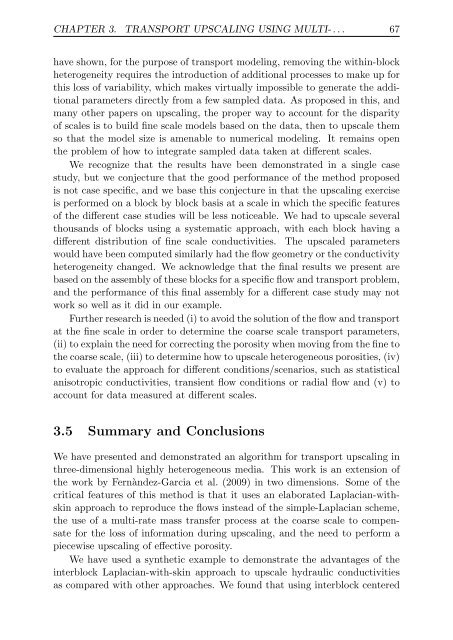Upscaling and Inverse Modeling of Groundwater Flow and Mass ...
Upscaling and Inverse Modeling of Groundwater Flow and Mass ...
Upscaling and Inverse Modeling of Groundwater Flow and Mass ...
Create successful ePaper yourself
Turn your PDF publications into a flip-book with our unique Google optimized e-Paper software.
CHAPTER 3. TRANSPORT UPSCALING USING MULTI- . . . 67<br />
have shown, for the purpose <strong>of</strong> transport modeling, removing the within-block<br />
heterogeneity requires the introduction <strong>of</strong> additional processes to make up for<br />
this loss <strong>of</strong> variability, which makes virtually impossible to generate the additional<br />
parameters directly from a few sampled data. As proposed in this, <strong>and</strong><br />
many other papers on upscaling, the proper way to account for the disparity<br />
<strong>of</strong> scales is to build fine scale models based on the data, then to upscale them<br />
so that the model size is amenable to numerical modeling. It remains open<br />
the problem <strong>of</strong> how to integrate sampled data taken at different scales.<br />
We recognize that the results have been demonstrated in a single case<br />
study, but we conjecture that the good performance <strong>of</strong> the method proposed<br />
is not case specific, <strong>and</strong> we base this conjecture in that the upscaling exercise<br />
is performed on a block by block basis at a scale in which the specific features<br />
<strong>of</strong> the different case studies will be less noticeable. We had to upscale several<br />
thous<strong>and</strong>s <strong>of</strong> blocks using a systematic approach, with each block having a<br />
different distribution <strong>of</strong> fine scale conductivities. The upscaled parameters<br />
would have been computed similarly had the flow geometry or the conductivity<br />
heterogeneity changed. We acknowledge that the final results we present are<br />
based on the assembly <strong>of</strong> these blocks for a specific flow <strong>and</strong> transport problem,<br />
<strong>and</strong> the performance <strong>of</strong> this final assembly for a different case study may not<br />
work so well as it did in our example.<br />
Further research is needed (i) to avoid the solution <strong>of</strong> the flow <strong>and</strong> transport<br />
at the fine scale in order to determine the coarse scale transport parameters,<br />
(ii) to explain the need for correcting the porosity when moving from the fine to<br />
the coarse scale, (iii) to determine how to upscale heterogeneous porosities, (iv)<br />
to evaluate the approach for different conditions/scenarios, such as statistical<br />
anisotropic conductivities, transient flow conditions or radial flow <strong>and</strong> (v) to<br />
account for data measured at different scales.<br />
3.5 Summary <strong>and</strong> Conclusions<br />
We have presented <strong>and</strong> demonstrated an algorithm for transport upscaling in<br />
three-dimensional highly heterogeneous media. This work is an extension <strong>of</strong><br />
the work by Fernàndez-Garcia et al. (2009) in two dimensions. Some <strong>of</strong> the<br />
critical features <strong>of</strong> this method is that it uses an elaborated Laplacian-withskin<br />
approach to reproduce the flows instead <strong>of</strong> the simple-Laplacian scheme,<br />
the use <strong>of</strong> a multi-rate mass transfer process at the coarse scale to compensate<br />
for the loss <strong>of</strong> information during upscaling, <strong>and</strong> the need to perform a<br />
piecewise upscaling <strong>of</strong> effective porosity.<br />
We have used a synthetic example to demonstrate the advantages <strong>of</strong> the<br />
interblock Laplacian-with-skin approach to upscale hydraulic conductivities<br />
as compared with other approaches. We found that using interblock centered


